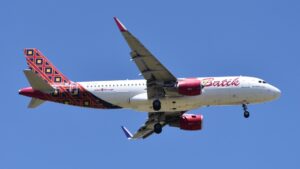
Batik Air Airbus A320
Photo credit: Bahnfrend (https://tinyurl.com/aek44jam)
What happens if both pilots fall asleep mid-flight?
On January 25, 2024, an Indonesian Batik Air flight encountered a startling incident where both pilots fell asleep for 28 minutes from Sulawesi to Jakarta.
The potential consequence of such an event is that the plane will continue on its programmed flight plan on autopilot until it runs out of fuel. This outcome, though very remote, could end up almost like Helios Airways flight where both pilots were incapacitated due to hypoxia.
Thankfully the above catastrophe did not arise as the pilots were awakened 28 minutes later. Heck, the plane had flown for almost 390 km (240 miles) unmanned and woefully off course! The captain immediately corrected his heading and navigated for a safe landing at the destination.
Of course, this is not the first time of both pilots fallen asleep in flight. I have heard stories of pilots who woke up and found that everyone had been asleep because all of them had been fighting the need for sleep and they all lost.
According to a NASA study on fatigue, tired people can experience brief periods of ‘micro sleep’ or even minutes-long lapses when the eyes are open but the brain is on hold.
They have also found that naps of up to 40 minutes are both safe and effective for pilots on trips of more than seven hours.
However, FAA have decided not to pursue the idea of allowing naps in flight due to the potential litigious suits that could arise should an accident occur while a pilot was napping.
The way around this is to define such shut-eye activity as a ‘controlled rest’. For this to happen, there are stringent rules to be followed. Once all safeguards are satisfied then only pilots are permitted to sleep during flight.
Not all airlines permit this on long flights. When allowed, they are usually seen on flights of up to eight hours with two-man crew. Such naps should only occur during non-critical stages of the flight. They are not allowed during any planned changes of flight levels, having to perform any fuel transfer or at a period when there is a forecast of bad weather.
Once all the safety procedures have been addressed, only then can the pilot take a nap of about 20 to 40 minutes in his cockpit seat.
The airline industry is also aware that long range flights do involve hours of low crew activity. At times, one pilot may fall asleep, normally with the consent of the other. In spite of his best effort to stay awake, the second pilot will occasionally doze off as well
As such, a pilot response monitor was developed. When it senses no buttons or selections are touched, the plane will issue an advisory warning “PILOT RESPONSE” in 15 minutes and finally an aural alert will sound 5 minutes later. This is sufficient to wake a pilot under any circumstances!
Unfortunately, this system is usually installed in long-range airliners and typically absent in short-haul planes.
View a YouTube video “Plane Veers Off Flight Path As Two Pilots Fall Asleep”
here https://www.youtube.com/watch?v=f9vKmP0SXAw
View a YouTube “Two pilots fall asleep mid-flight, plane flies off course”